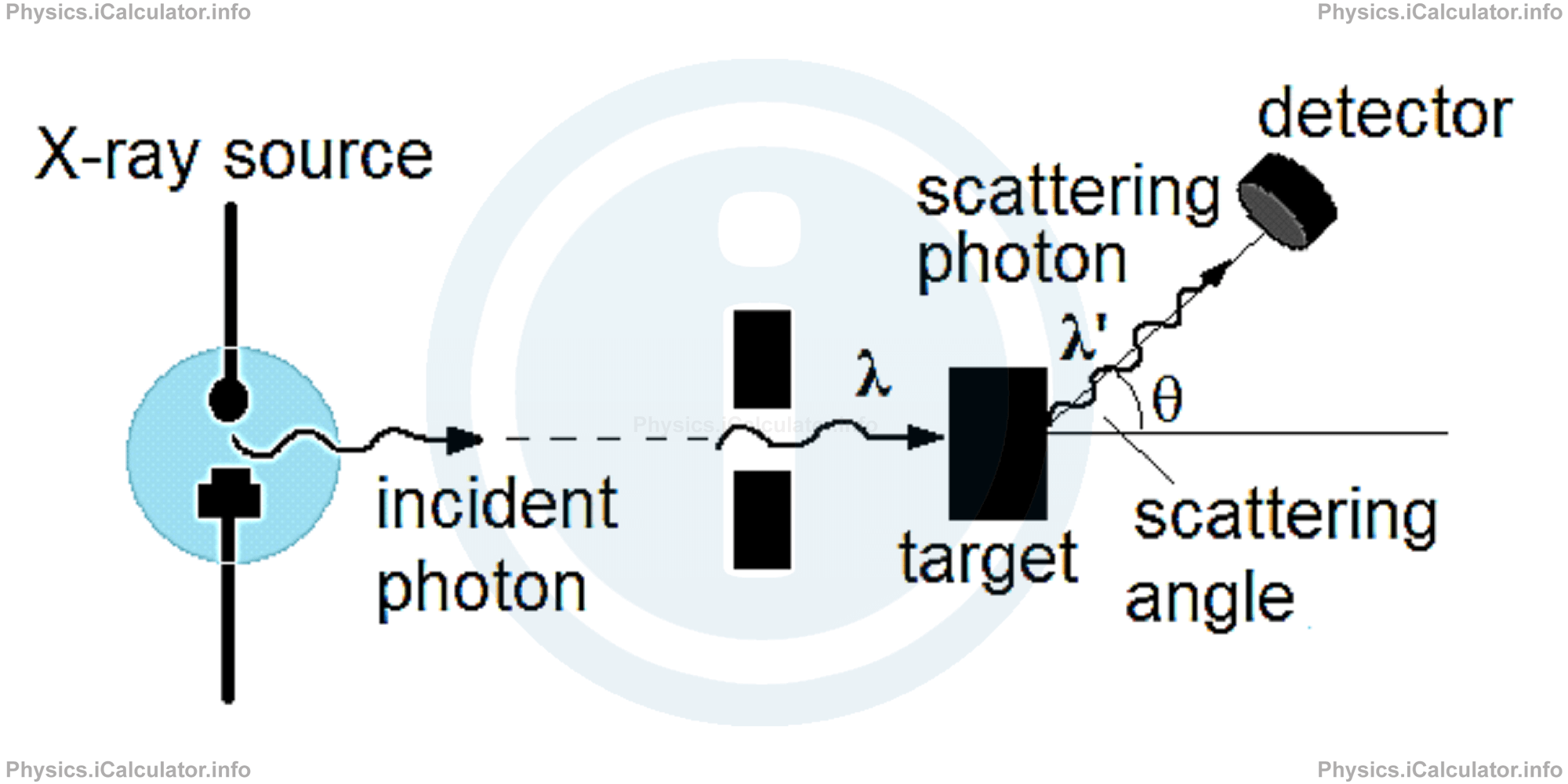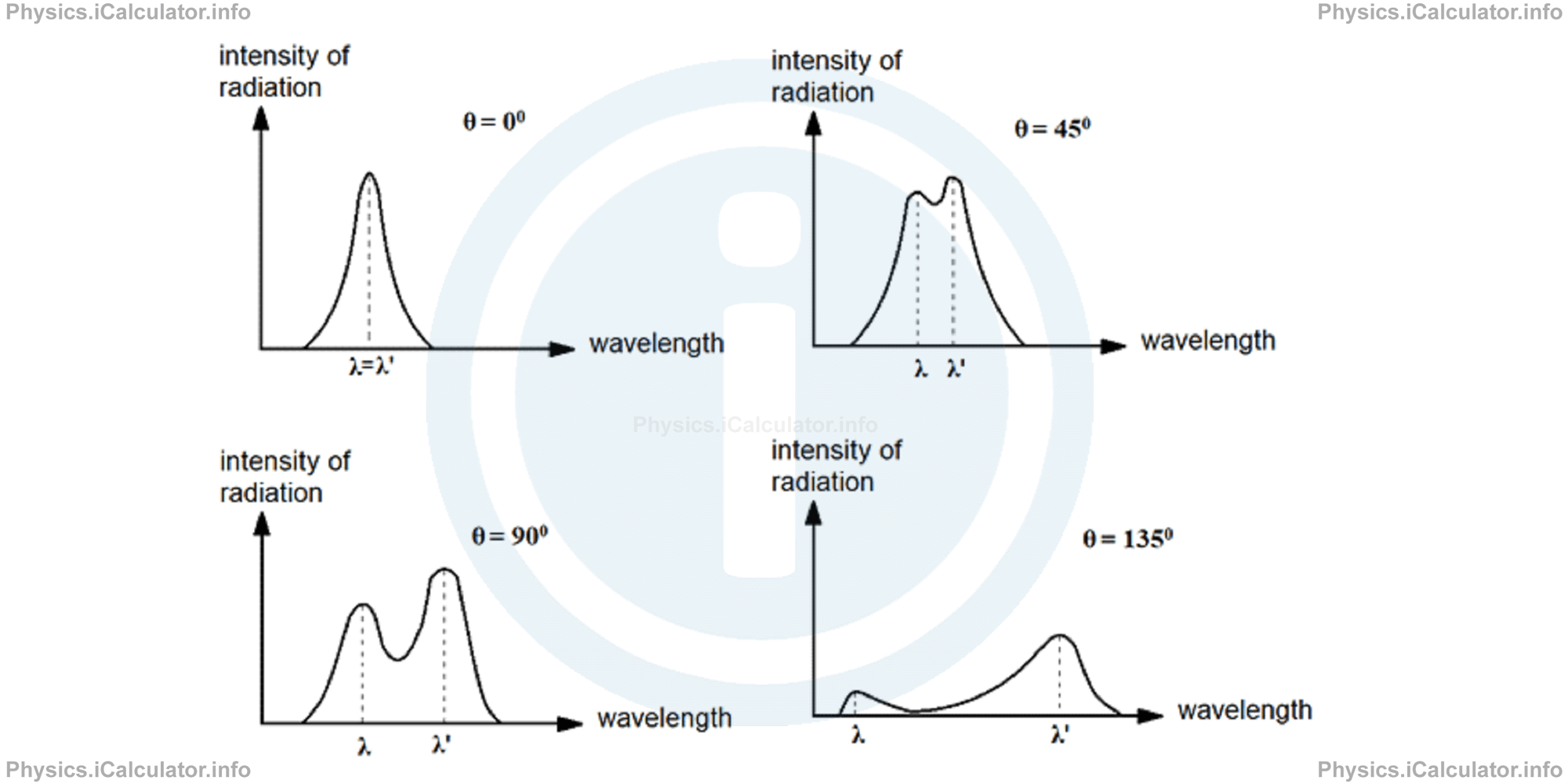Menu
Physics Lesson 19.3.2 - Quantum Interpretation of Compton Scattering
Please provide a rating, it takes seconds and helps us to keep this resource free for all to use
Welcome to our Physics lesson on Quantum Interpretation of Compton Scattering, this is the second lesson of our suite of physics lessons covering the topic of The Compton Effect and Pressure of Light, you can find links to the other lessons within this tutorial and access additional physics learning resources below this lesson.
Quantum Interpretation of Compton Scattering
The figure below shows the scheme of experiment made by Compton to explain the scattering effect when X-rays strike the surface of a crystal.

The detector records the radiation scattered by θ degrees and also calculates the wavelength λ' of the scattered radiation. Compton found experimentally that the change in wavelength Δλ between the scattered radiation λ' and incident radiation λ depend only by the scattering angle θ. Mathematically, this dependence is written as
The quantity λC (which obviously has the unit of wavelength) is known as the "Compton wavelength". It is a constant and its value is found experimentally (λC = 0.00243 nm = 2.43 × 10-12 m).
By analyzing the Compton formula, it is evident that the change in wavelength increases with the increase in the scattering angle. The figure below shows the data recorded by the detector for four different scattering angles (0°, 45°, 90° and 135°). The detector records in a given time the relative intensities of radiation and wavelengths for both components of diffused radiation - coherent and non-coherent.

From the graphs, you can see that for EM waves moving in the original direction (θ = 0°) there is no Compton Effect (waves are not scattered). On the other hand, the effect is more visible for a 135° scattering angle than for 45° or 90° (coherent and non-coherent scattered wavelengths are more distant from each other, where coherent wavelengths move in the original direction of incident waves).
Compton's formula can be obtained theoretically only when considering the particle nature of X-radiation. For this purpose, Compton observed the interaction of photons produced by the X-radiation and the weakly bonded electrons. This interaction is a perfectly elastic collision in which both energy and momentum of the photon-electron system are conserved. Compton found theoretically that
where m is the mass of electron (m = 9.1 × 10-31 kg), h is Planck's constant (h = 6.626 × 10-34 J · s) and c is the speed of light in vacuum (c = 3 × 108 m/s).
Comparing the two formulae of Compton effect, it is clear that the Compton wavelength λC is
Let's find the value of Compton wavelength and compare it with the experimental value given earlier (2.43 × 10-12 m). Thus, substituting the known values, we obtain
= 2.4271 × 10-12 m
≈ 2.43 × 10-12 m
This value is equal to the experimental value found by Compton. Likewise, we can determine the value of Planck Constant using the value of Compton wave found experimentally and so on.
Example 1
Calculate the wavelength of X-radiation scattered at 600 to the original direction if the incident wavelength is 0.02183 nm. (cos 600 = 0.500, sin 600 = 0.866)
Solution 1
Clues:
θ = 30°
λ = 0.02183 nm = 2.183 × 10-11 m)
(λC = 2.43 × 10-12 m)
λ' = ?
Using the Compton Formula
where Δλ = λ' - λ, we obtain for the scattered wavelength after substitutions
λ' = λ + λC ∙ (1 - cosθ )
= (2.183×10-11 m) + (2.43 × 10-12 m) ∙ (1 - 0.500)
= (2.183×10-11 m) + (1.215 × 10-12 m)
= 3.398 × 10-12 m
You have reached the end of Physics lesson 19.3.2 Quantum Interpretation of Compton Scattering. There are 5 lessons in this physics tutorial covering The Compton Effect and Pressure of Light, you can access all the lessons from this tutorial below.
More The Compton Effect and Pressure of Light Lessons and Learning Resources
Whats next?
Enjoy the "Quantum Interpretation of Compton Scattering" physics lesson? People who liked the "The Compton Effect and Pressure of Light lesson found the following resources useful:
- Quantum Interpretation Feedback. Helps other - Leave a rating for this quantum interpretation (see below)
- Modern Physics Physics tutorial: The Compton Effect and Pressure of Light. Read the The Compton Effect and Pressure of Light physics tutorial and build your physics knowledge of Modern Physics
- Modern Physics Revision Notes: The Compton Effect and Pressure of Light. Print the notes so you can revise the key points covered in the physics tutorial for The Compton Effect and Pressure of Light
- Modern Physics Practice Questions: The Compton Effect and Pressure of Light. Test and improve your knowledge of The Compton Effect and Pressure of Light with example questins and answers
- Check your calculations for Modern Physics questions with our excellent Modern Physics calculators which contain full equations and calculations clearly displayed line by line. See the Modern Physics Calculators by iCalculator™ below.
- Continuing learning modern physics - read our next physics tutorial: De Broglie Wave
Help others Learning Physics just like you
Please provide a rating, it takes seconds and helps us to keep this resource free for all to use
We hope you found this Physics lesson "The Compton Effect and Pressure of Light" useful. If you did it would be great if you could spare the time to rate this physics lesson (simply click on the number of stars that match your assessment of this physics learning aide) and/or share on social media, this helps us identify popular tutorials and calculators and expand our free learning resources to support our users around the world have free access to expand their knowledge of physics and other disciplines.
Modern Physics Calculators by iCalculator™
- Characteristic Em Wavelength Calculator
- De Broglie Wave Calculator
- Rayleigh Jeans Relation Calculator
- Energy Of Photons Calculator
- Intensity Photoelectric Effect Calculator
- Kinetic Photoelectric Effect Calculator
- Light Pressure Calculator
- Radiation Black Body Calculator
- Stopping Voltage Photoelectric Effect Calculator
- Uncertainty Calculator
- Wave Width Calculator
- Scattered Radiation Compton Effect Calculator
- De Broglie Packet Calculator